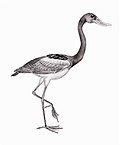| Aythya | |
|---|---|
 | |
| Greater scaup (Aythya marila), the type species of Aythya | |
| Scientific classification | |
| Domain: | Eukaryota |
| Kingdom: | Animalia |
| Phylum: | Chordata |
| Class: | Aves |
| Order: | Anseriformes |
| Family: | Anatidae |
| Tribe: | Aythyini |
| Genus: | Aythya F. Boie, 1822 |
| Type species | |
| Anas marila [1] Linnaeus, 1761 | |
| Species | |
12 species, see text | |
Aythya is a genus of diving ducks, with twelve species currently accepted. [2] The genus was described in 1822 by the German zoologist Friedrich Boie, with the type species being greater scaup. [3] [4] The name Aythya comes from the Ancient Greek word αἴθυιᾰ (aithuia), which referred to an unknown diving-bird. [5] [6]
Contents

The species are plump, compact, medium-sized ducks ranging from 37–61 cm long, 60–84 cm wingspan, and weighing 410–1600 g, with canvasback the largest, and ring-necked duck and ferruginous duck marginally the smallest. The body plumage is variably white, grey, red-brown, or black, often with a finely vermiculated pattern; in several species, the flanks are white or pale grey, the back darker grey to black, and the breast and tail black. The heads are strongly coloured in the males, orange-red in some species, and black with a green to purple sheen (structural colour) in good light; the sheen colour varies with both species and angle of light incidence – in for example greater scaup, the head has a green sheen in direct light, but a purple sheen when backlit. In females, the heads are browner, sometimes with white patterning on the face. The eye colour is also variable in males, from white in ferruginous duck (leading to its archaic name of "white-eyed pochard"), through yellow in most species, to deep red in common pochard and canvasback; in females, the eye is brown in all species. The bills are short, fairly broad, and pale blue-grey to black, usually with a small black 'nail' at the tip; the pattern of blue-grey and black is important in species identification. In flight, the wings are dark grey to black, with a white to pale grey wingbar along the primary and secondary feathers; the pattern of the wingbar (whether all-white, or all-grey, or white on the secondaries and grey on the primaries) is an important identification feature. The webbed feet, used for propulsion in both swimming and diving, are 5–7 cm long, large for the size of the birds, and dark grey to blackish in all the species. [7] [8]
The species occur throughout Asia, Europe, North America, Australia, New Zealand, and Madagascar, and also in the northern half of Africa primarily in winter. Small numbers also reach the far north of South America in winter. In the breeding season, they are restricted to well-vegetated freshwater lakes, while in the winter they use both freshwater lakes and sheltered saltwater bays and inlets. [7]




































